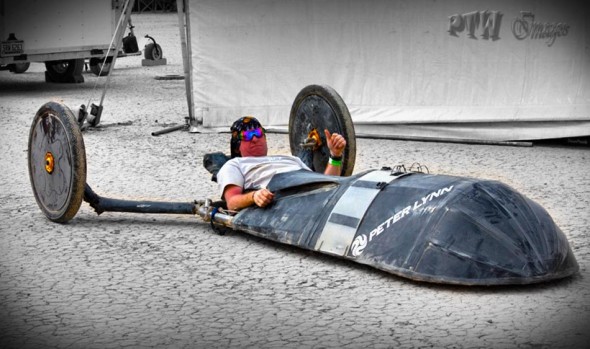More Speed Buggies?
popeyethewelder.com/facebook questions
2012
-
Nick Thompson – Apart from the Peter Lynn speed buggy has the been any other attempt at making an aerodynamic buggy.
-
Carlos Fandango – Yes Jon Ellis, was making a aerodynamic buggy for a speed attempt, and it was coming along nicely, unfortunately the project got shelved, also Xxtreme had a go at make a front wind deflector, but I dont think it was very successful
- Davis Cheek – I looked at the PL speed buggy and was curious as to if there had been any wind tunnel testing? Low, wide and round does have it’s “better than nothing” aero advantages.
- The average buggy that we all have and love are not aerodynamic at all. For the every day buggy pilot there might be some cheap simple aero tricks that could help boost speed.
- Start with a 250 degree front wheel cover with an air flow diverter (small molded wing) to move air up over the neck at an angle that lines up with your helmet. I believe that this would create a smooth flow over the tire and the body to reduce the drag of what you are wearing. I’m thinking that the shape might look like a small Hammer Head sharks head. F-1 inspired.
- I would also develop foot peg aero diverters that move air around the boots. If you look from the front of a buggy with a pilot sitting with feet on the pegs you’ll see two large flat air breaks. Again, move the air up, over and around like the aero wings on the F-1 front wheels.
- The side # boards need to be lower to the ground with a light flexible skirt that is about a 1/2 to 1/4″ off the surface. Make the side boards terminate under the neck in the shape of a “V” as a part of a belly pan system that goes all the way to the rear axle. This should make for a smooth flow of air under the buggy. The length of the PL speed buggy under side had to cause some drag and it should have terminated as a pointed or flat squared rear end.
- The rear wheels need covers also. A 1/3 cover starting just above the surface of the tarmac with wing-lets at top center that will move air up, over and around the tires and create some down force on the rear axle as well. For barrows and/or big foots, because that’s what most of us run. Hub caps will also eliminate some drag.
- These parts can be molded from HDEP, fiberglass, carbon fiber or aluminum. As you can tell, I’ve been thinking about this for some time now and will have some drawings off the drawing board soon. Still looking for a “Flux Capacitor”
- Carl, you should look at developing the brackets necessary to mount all this hardware. Some easy pop on pop off attachments so all this crap could be mounted once at the flying spot.
-
I guess that a streamliner class will have to be created for speed record attempts.
-
Carlos Fandango – Link PL Speed Buggy
- Interesting….shall we make one, and go for it….I have the pilot ready to go
- Craig Hansen – I like the sound of this…….
-
Jerry Routh – But you need a kite as well any thoughts. Been thinking about for a bit.
- KiteBuggy BagMan – still not sure about all this aerodynamics bit, there is so little between the top 3, and only 1.5mph between the top 2. Probably the fact the Pl buggy was so weighted down did more for the top end.
- How modded was the XX buggy, or was it not far off being a Std Setup. If there were more between the speeds it might make a difference. also remember we are usually going “slightly” down wind to reach max speed, If the wind is blowing 50 and you are doing 80 the head wind must be lower. (i am sure someone will correct me if i am talking bollox here!). If there were a massive difference between the speeds then maybe so, but whats the weight difference between the Speed buggy and the XX.
- Saying that though, How big is the XX pilot, i have heard they are big chaps over there!!! lol

